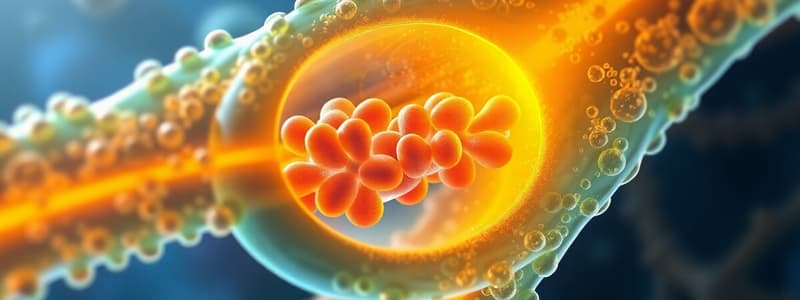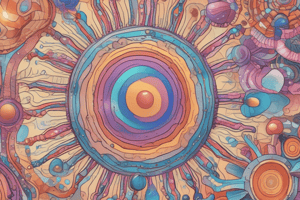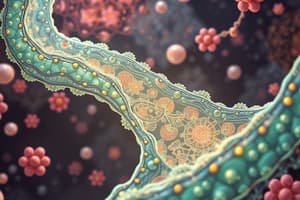Podcast
Questions and Answers
What is the primary function of the sodium-dependent co-transport carrier system in intestinal epithelial cells?
What is the primary function of the sodium-dependent co-transport carrier system in intestinal epithelial cells?
- To facilitate the hydrolysis of ATP for energy
- To co-transport glucose and amino acids against their concentration gradients (correct)
- To maintain a potassium gradient across the membrane
- To transport sodium ions solely into the cell
Which of the following describes the action of the sodium/potassium pump (Na+/K+-ATPase)?
Which of the following describes the action of the sodium/potassium pump (Na+/K+-ATPase)?
- It uses glucose as the primary energy source
- It transports 3 K+ ions from inside to outside of the cell
- It operates independently of ATP hydrolysis
- It maintains a Na+ gradient by moving 3 Na+ ions out of the cell and 2 K+ ions into the cell (correct)
What type of energy does secondary active transport primarily rely on?
What type of energy does secondary active transport primarily rely on?
- Potential energy stored in cellular membranes
- The concentration gradients created by ion pumps (correct)
- Chemical energy from ATP
- Thermal energy from surrounding environment
Which of the following is NOT a characteristic of microtransfer across cell membranes?
Which of the following is NOT a characteristic of microtransfer across cell membranes?
In which mechanism does secondary active transport occur?
In which mechanism does secondary active transport occur?
Which statement best describes the role of membrane transport in cell survival?
Which statement best describes the role of membrane transport in cell survival?
What distinguishes macrotransfer from microtransfer?
What distinguishes macrotransfer from microtransfer?
Which of the following processes falls under the category of passive diffusion?
Which of the following processes falls under the category of passive diffusion?
How do transporter proteins differ from channel proteins?
How do transporter proteins differ from channel proteins?
What is facilitated transport?
What is facilitated transport?
Which mechanism is responsible for glucose entry into cells?
Which mechanism is responsible for glucose entry into cells?
What aspect is not part of the intracellular environment?
What aspect is not part of the intracellular environment?
Which process is involved in the exchange between neighboring and surrounding intercellular mediums?
Which process is involved in the exchange between neighboring and surrounding intercellular mediums?
What size must particles be to exhibit Brownian movement?
What size must particles be to exhibit Brownian movement?
What is the primary driving force for diffusion?
What is the primary driving force for diffusion?
What type of transport requires energy to move substances across a cell membrane?
What type of transport requires energy to move substances across a cell membrane?
What type of transport allows water and small non-polar molecules to pass through a membrane freely?
What type of transport allows water and small non-polar molecules to pass through a membrane freely?
Which molecules enter cells through facilitated diffusion?
Which molecules enter cells through facilitated diffusion?
Which type of transport solely involves bringing materials into endosomes or lysosomes?
Which type of transport solely involves bringing materials into endosomes or lysosomes?
What determines the rate of facilitated diffusion?
What determines the rate of facilitated diffusion?
What characterizes passive transport?
What characterizes passive transport?
Which of the following is NOT a method of microtransfer?
Which of the following is NOT a method of microtransfer?
What happens to the rate of diffusion when all carrier proteins are saturated?
What happens to the rate of diffusion when all carrier proteins are saturated?
What process is NOT required for facilitated transport?
What process is NOT required for facilitated transport?
What is the main difference between passive and active transport?
What is the main difference between passive and active transport?
Which of the following best describes facilitated diffusion?
Which of the following best describes facilitated diffusion?
Which type of transport involves the engulfing of larger particles by the cell?
Which type of transport involves the engulfing of larger particles by the cell?
What is the function of exocytosis in a cell?
What is the function of exocytosis in a cell?
Macromolecules and charged ions require what type of transport mechanism?
Macromolecules and charged ions require what type of transport mechanism?
What must occur for diffusion to cease?
What must occur for diffusion to cease?
Which mechanism does NOT involve the uniform distribution of molecules?
Which mechanism does NOT involve the uniform distribution of molecules?
What process allows small molecules and ions to cross cell membranes without energy usage?
What process allows small molecules and ions to cross cell membranes without energy usage?
What is required for macrotransfer to occur?
What is required for macrotransfer to occur?
What is the primary function of membrane transport proteins?
What is the primary function of membrane transport proteins?
Which statement accurately describes primary active transport?
Which statement accurately describes primary active transport?
What is a characteristic feature of secondary active transport?
What is a characteristic feature of secondary active transport?
How do temperature changes impact active transport systems?
How do temperature changes impact active transport systems?
In terms of proton pumps, what role does ATP play?
In terms of proton pumps, what role does ATP play?
Which of the following best describes symport transport?
Which of the following best describes symport transport?
Which molecules are typically involved in active transport systems?
Which molecules are typically involved in active transport systems?
What distinguishes antiport transport from symport transport?
What distinguishes antiport transport from symport transport?
What happens to Na+, K+, and Cl- ions at the cellular membrane?
What happens to Na+, K+, and Cl- ions at the cellular membrane?
Why is ATP crucial for active transport processes?
Why is ATP crucial for active transport processes?
Flashcards
Membrane Transport
Membrane Transport
The movement of substances across the plasma membrane, which is the outer layer of a cell.
Intracellular Environment
Intracellular Environment
The conditions inside a cell.
Intercellular Environment
Intercellular Environment
The conditions surrounding a cell, including fluid and other cells.
Exchange between Neighbouring Cells
Exchange between Neighbouring Cells
Signup and view all the flashcards
Exchange within the cell
Exchange within the cell
Signup and view all the flashcards
Exchange between the surrounding medium
Exchange between the surrounding medium
Signup and view all the flashcards
Membrane Transport - Importance
Membrane Transport - Importance
Signup and view all the flashcards
Microtransfer
Microtransfer
Signup and view all the flashcards
Passive Transport
Passive Transport
Signup and view all the flashcards
Passive Diffusion
Passive Diffusion
Signup and view all the flashcards
Phagocytosis
Phagocytosis
Signup and view all the flashcards
Pinocytosis
Pinocytosis
Signup and view all the flashcards
Receptor-mediated endocytosis
Receptor-mediated endocytosis
Signup and view all the flashcards
Active Transport
Active Transport
Signup and view all the flashcards
Exocytosis
Exocytosis
Signup and view all the flashcards
Fluid-phase endocytosis
Fluid-phase endocytosis
Signup and view all the flashcards
Diffusion
Diffusion
Signup and view all the flashcards
Equilibrium
Equilibrium
Signup and view all the flashcards
Saturation
Saturation
Signup and view all the flashcards
Concentration Gradient
Concentration Gradient
Signup and view all the flashcards
Facilitated Diffusion
Facilitated Diffusion
Signup and view all the flashcards
Carrier Proteins
Carrier Proteins
Signup and view all the flashcards
Freely Permeable Molecules
Freely Permeable Molecules
Signup and view all the flashcards
Osmosis
Osmosis
Signup and view all the flashcards
Membrane Transport Proteins
Membrane Transport Proteins
Signup and view all the flashcards
Active Transport: Moving Against the Gradient
Active Transport: Moving Against the Gradient
Signup and view all the flashcards
Primary Active Transport
Primary Active Transport
Signup and view all the flashcards
Secondary Active Transport
Secondary Active Transport
Signup and view all the flashcards
Symport
Symport
Signup and view all the flashcards
Antiport
Antiport
Signup and view all the flashcards
Proton Pump
Proton Pump
Signup and view all the flashcards
Electrochemical Gradient
Electrochemical Gradient
Signup and view all the flashcards
Homeostasis
Homeostasis
Signup and view all the flashcards
Study Notes
Biological Membranes: Transport I (Microtransfer)
- Course: Fundamentals of Human Biology
- Code: FUNBIO.8
- Lecturer: Dr. Irene Oglesby
- Date: 14th October 2024
- Year: Foundation Year
Learning Outcomes
- ALO1: Contrast and compare intracellular and intercellular environments
- ALO2: Differentiate between macrotransfer and microtransfer processes
- ALO3: Describe passive diffusion processes and membrane transport proteins' role
- ALO4: Differentiate between transporter and channel proteins
- ALO5: Explain facilitated transport
- ALO6: Describe mechanisms of active transport in cell membranes
- ALO7: Explain how glucose enters cells via sodium-dependent co-transport
Membrane Transport
- Involves substance movement across plasma membranes
- Nutrients and oxygen must enter; waste products must exit for metabolism
Membrane Transport - Intracellular vs. Intercellular
- Cell survival depends on exchange
- Between neighboring cells
- Within the cell (intracellular environment)
- With the surrounding intercellular medium (extracellular matrix)
Membrane Transport Mechanisms
- Macrotransfer: Transport of macromolecules
- Materials are brought into endosomes or lysosomes within the cytoplasm
- Molecules must cross the surrounding membrane to enter the cytoplasm
- Microtransfer: Transport of small molecules and ions across cell membranes (internal and external)
Microtransfer Mechanisms
- Passive Transport: No energy required
- Simple diffusion: Movement along concentration gradient
- Brownian movement: Random movement of particles less than 2µm
- Molecules move from high to low concentrations till evenly distributed
- Active Transport: Requires energy
- Moves molecules against concentration gradient
Passive Transport
- No energy required
Facilitated Transport
- Uses carrier proteins (permeases)
- Highly selective, often transporting one type of molecule
- Facilitates the transport of sugars, amino acids, and nucleotides
- Essentially a passive transport system (no direct energy required)
- Affected by carrier binding site saturation and concentration gradient
Active Transport
- Requires energy (ATP)
- Transports macromolecules and charged ions (H+, Na+, K+, Cl−) across membranes against concentrations gradients
- Involves selective pores and channels (membrane transport proteins)
- Types:
- Primary Active Transport: Moves molecules against electrochemical gradient directly using ATP energy.
- Secondary Active Transport: Uses electrochemical gradient of one molecule to transport a second molecule against its gradient.
- Can be symport (molecules move in the same direction) or antiport (molecules move in opposite directions).
Sodium-Dependent Co-Transport (Symport)
- Important in intestinal epithelial cells
- Drives glucose, other monosaccharides, amino acids, and pyrimidines into cells
- Glucose and sodium ions move together in the same direction (symport)
Active Transport - Antiport System
- Most membranes have ATP-driven sodium/potassium pumps (Na+/K+-ATPase)
- Maintains a sodium gradient
- Transports 3 Na+ ions outward, 2 K+ ions inward using one ATP
- Antiport transports molecules in opposite directions
Models of Active Transport
- Integral transmembrane proteins act as carriers, moving substances between cell surfaces.
- Proton pumps use ATP energy to move protons (H+) across membranes. The resulting electrochemical gradient can be used for other processes.
Summary - Membrane Transport (Microtransfer)
- Microtransfer is the transport of small molecules and ions across cell membranes (internal or external)
- Includes diffusion, facilitated diffusion, passive transport, and active transport
- Active transport requires ATP; passive transport, facilitated, and diffusion do not.
Studying That Suits You
Use AI to generate personalized quizzes and flashcards to suit your learning preferences.




